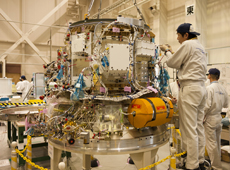
--- What kind of work do you do exactly?

All-staff meeting (courtesy: JAXA/JOE NISHIZAWA)
I organize working groups for each part of the project, which then take responsibility for certain tasks. But because a vertical organization in each area of responsibility will not operate effectively on its own, we also need interdisciplinary approaches. I’m always taking the long view with a project, and when a group cannot solve something by itself, then when necessary I’ll coordinate things for the entire team. In addition, I am in charge of liaison with spacecraft project teams, and with officials from the national and local governments.
--- Project Manager Morita set a goal of creating a mobile control system. Do you think you have achieved that?
I think it would be partly true to say that when Project Manager Morita publicly announced that we would create a mobile control system, I worked to make that happen. But I didn’t work on the mobile control system just because he told me to. We’d already had the idea of simplifying rockets and ground equipment, so to make that happen we decided to try to create a launch and control system using personal computers and staffed by only a few people. That’s what led to the mobile control system.
--- Why were you so focused on simplification?
Because a solid-fuel rocket itself is a simple thing, so we were sure we could use its characteristics to simplify it further. For example, you can load fuel into a solid-fuel rocket at the factory and then take it to the launch pad. A liquid-propellant rocket, on the other hand, has to be fueled up at the launch pad on the day of the launch. The liquid hydrogen in the fuel has to be kept at the extremely low temperature of -253°C so if outside air comes into contact with the fuel and the water vapor in that air freezes, you have a problem. Therefore you have to surround the fuel with nitrogen and the like – no water vapor – which is a troublesome task requiring large pieces of equipment, many people, and a lot of time. Solid-fuel rockets don’t need all this equipment, so that alone lightens the burden. When I worked on the H-IIA Launch Vehicle, it was a complex affair, and I personally experienced the difficulties involved, so we developed the Epsilon Launch Vehicle with the idea of simplifying things. Thinking back to that time, we focused on simplifying both the rocket itself and the launch equipment.
--- What was the most difficult time for you on this project?

Epsilon in development (courtesy: JAXA/JOE NISHIZAWA)
I would have to say the most difficult time was two-and-a-half months before launch. The people in charge of the satellite Epsilon-1 was to carry requested that we launch by August 2013, so we had to build the rocket in a short span of three years. The H-IIA took seven or eight years of research and development, so you can imagine how short a timeframe this was. Yet in the end we were able to accept this challenge. We endured a difficult schedule with nearly no breaks from the time the rocket was relocated to the Uchinoura Space Center in June. And at the same time as we were preparing for launch, I had to coordinate the remaining development tests for Epsilon-1, as well as reviewing and coordinating plans for future launches. I was doing three things at once, and it was incredibly tiring. I was so busy, I honestly thought I was going to die. Even so, I remained entirely focused on this work up until the August 27 launch date, but then we had a shutdown at the last minute... At that point, all of a sudden I became mentally drained.
--- How did you get over this mental slump?

Launch of the first Epsilon Launch Vehicle
When I calmed down a bit after the cause of the malfunction was found, I took a day and a half off and refreshed myself. I was determined not to take a step off the Uchinoura site until the rocket launched, so I rested there without returning to my family. It was nice that a lot of children and other people were cheering us on at that time. I received hand-colored letters saying “We support you!” and people told me, “Don’t give up!” Somebody even said to me, “The prototype is really important, so this is better than a failed launch, right?” That support encouraged me, and I was able to get my head straight.
--- How did you feel the moment the launch succeeded?
I thought of how the team had come together and really done their best. I was very relieved when Epsilon, which I call “Everybody’s Rocket,” launched without a hitch. When I worked on the H-IIA, my boss at the time said I should “just give it a try” and build that rocket. We started off with only a few people on the project, and a project manager and I from that time were involved from beginning to end. That’s why I really felt I’d done my best, and even my daughter said to me, “That’s Dad’s rocket.” I too strongly felt it was “my rocket,” although in reality everybody involved worked hard on it. (Laughs.) Perhaps it was youthful exuberance, or I was just absorbed in the moment. But I’ve matured since then, and now I think of Epsilon as “everybody’s rocket”... Of course I have to do my best for myself, but I also felt I wanted to build a rocket that everyone could be passionate about developing. As a result, the young 20- and 30-somethings on the team gave it their all, and I think Epsilon truly did become everybody’s rocket. That made me incredibly happy, and it was one of the feelings I had when the launched succeeded.
--- Epsilon is a rocket that combines technology from the H-IIA, developed by the former National Space Development Agency (NASDA), and the M-V, developed by the Institute of Space and Astronautical Science (ISAS). Was it difficult to bring together people from different organizations?

Epsilon is the culmination of H-IIA and M-V technologies
Around the time research on Epsilon had just begun, the ISAS people looked a little down because the M-V program had ended. Myself, I wanted the people who had worked on the M-V to enjoy even greater successes than before, so there were times when I thought about what I could do to get them to exert greater effort on this project. Furthermore, different terminology and processes are used for solid-fuel and liquid-propellant rockets, and that caused some confusion. But those matters were resolved over time, and people from the two organizations shared the goal of building a good rocket.
I’m pleased that my efforts resulted in the formation of a good team that made the most of each person’s area of specialty. ISAS was originally a university research institute, so it has many scientists with specialized expertise. Therefore, there is no one better than them when it comes to fields such as structural and propulsion systems. Meanwhile, the former NASDA people are good at coordinating personnel and leading an organization as a whole. I don’t know if we could have coordinated the whole group as well as we did with the ISAS folks alone, and we may have somewhat neglected specialized fields if we’d had only the former NASDA employees. I feel they complemented each other well and became a good team.
--- Are there plans to apply the success of Epsilon to liquid-propellant rockets?
Development on a new basic rocket powered by liquid propellant is starting up, so we are sharing ideas with those people on what worked with Epsilon and where we should have done a bit better. For example, regarding the automatic, autonomous inspection system, we are considering whether the improvements we made for Epsilon would work for liquid-propellant rockets as well.
--- Forming a team of both solid-fuel and liquid-propellant rocket specialists and developing Epsilon is paying dividends.
Yes, it is. It’s really great that the solid-fuel and liquid-propellant experts formed one team. In addition, I would like to continue partnering with aircraft researchers as well. For example, we installed a flue on the launch pad to reduce noise at the time of launch, and we worked on this with people who are researching noise reduction for supersonic aircraft. I hope this style of using interdisciplinary collaboration becomes standard for the development of transport vehicles in the future.
--- Have you had an interest in rockets since you were a child?

I was in elementary school when I first had the idea that I wanted to do work related to outer space. Around that time I often watched Space Battleship Yamato, Galaxy Express 999 and Star Wars, and I thought space was cool. I didn’t decide that I specifically wanted to build rockets until much later, but I did want to do work involving space. I always had that in mind when deciding my path in life – signing up for science classes in high school, and studying aerospace engineering at university. I was so happy when I got hired at NASDA and my dream came true.
--- What, to you, is the ideal rocket?
I’d have to say a simple rocket. Lots of components make breakdowns more likely, plus they require a lot of manpower and time, and they’re more expensive. Fewer breakdowns means greater reliability, and this will eventually benefit reusable or manned rockets.
--- Can Epsilon be simplified any further?
Yes. For example, the electronics still have many components. There is a mountain of wiring now, but radio communication could reduce that amount. It would probably also reduce the number of cases that house the electronics. That would lower the rocket’s mass and enhance its launch capabilities. Furthermore, to build the rocket’s body, we cut it out of a thick lump of cylindrical metal. Cutting takes time, so if we could make it in a mold, then that would significantly reduce the effort required, and also lower costs. Adding these kinds of improvements would make Epsilon simpler, and steadily lead to a better rocket. Just wait and see what we do next!
--- Can you tell us about your future aspirations?
First I would be to build a better Epsilon. Then, in the future, I want to keep on developing excellent rockets, whether solid-fuel or liquid-propellant.
Submanager, Epsilon Rocket Project Team, Space Transportation Mission Directorate, JAXA
Mr. Imoto majored in applied dynamics at the Kyushu University Graduate School of Engineering. In 1989 he joined the National Space Development Agency (now part of JAXA) and worked on developing the engine and propulsion system for the H-II Launch Vehicle. After coordinating development of the H-IIA rocket, Mr. Imoto joined the Epsilon Launch Vehicle Project Team, where he has been in charge of coordinating development since Day 1.
Making good rockets requires more simplicity!
Epsilon Technology: A Link to the Future
Epsilon: A Soft and Comfortable Ride
The Anytime, Anywhere Rocket
Building a Versatile Rocket
